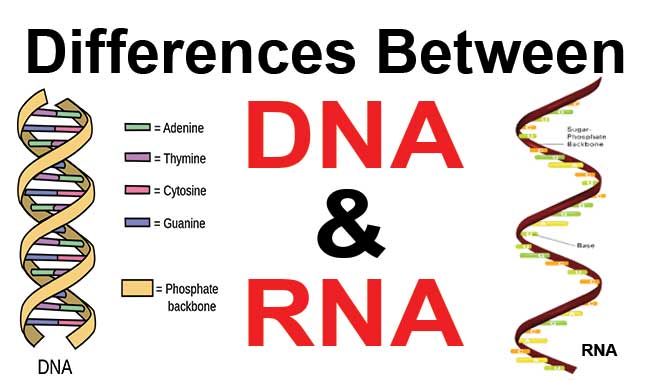Here are 17 differences between DNA and RNA.
| S.N. | DNA | RNA |
|---|---|---|
| 1. | DNA stands for Deoxyribonucleic Acid. The sugar portion of DNA is 2-Deoxyribose. | RNA stands for Ribonucleic Acid. The sugar portion of RNA is Ribose. |
| 2. | The helix geometry of DNA is of B-Form (A or Z also present). | The helix geometry of RNA is of A-Form. |
| 3. | DNA is a double-stranded molecule consisting of a long chain of nucleotides. | RNA usually is a single-strand helix consisting of shorter chains of nucleotides. |
| 4. | The bases present in DNA are adenine, guanine, cytosine and thymine. | The bases present in RNA are adenine, guanine, cytosine and uracil. |
| 5. | DNA is self-replicating. | RNA is synthesized from DNA on an as-needed basis. |
| 6. | Base Pairing :AT (adenine-thymine)GC (guanine-cytosine). | Base Pairing :AU (adenine-uracil)GC (guanine-cytosine). |
| 7. | Purine and Pyrimidine bases are equal in number. | There is no proportionality in between the number of Purine and Pyrimidine bases. |
| 8. | DNA is susceptible to UV damage. | Compared with DNA, RNA is relatively resistant to UV damage. |
| 9. | Hydrogen bonds are formed between complementary nitrogen bases of the opposite strands (A-T, C-G). | Base pairing through hydrogen bonds, occurs in the coiled parts. |
| 10. | DNA is found in the nucleus of a cell and in mitochondria. | Depending on the type of RNA, this molecule is found in a cell’s nucleus, its cytoplasm, and its ribosome. |
| 11. | DNA can’t leave the nucleus. | RNA leaves the nucleus (mRNA). |
| 12. | The C-H bonds in DNA make it fairly stable, plus the body destroys enzymes that would attack DNA. The small grooves in the helix also serve as protection, providing minimal space for enzymes to attach. | The O-H bond in the ribose of RNA makes the molecule more reactive, compared with DNA. RNA is not stable under alkaline conditions, plus the large grooves in the molecule make it susceptible to enzyme attack. |
| 13. | Renaturation after melting is slow. | It is quite fast. |
| 14. | DNA is only two types: intra nuclear and extra nuclear. | Three different types of RNA: m-RNA, t-RNA and r-RNA. |
| 15. | Its quantity is fixed for cell. | The quantity of RNA of a cell is variable. |
| 16. | It is long lived. | Some RNAs are very short lived while others have somewhat longer life. |
| 17. | Functions:Long-term storage of genetic information; transmission of genetic information to make other cells and new organisms. | Functions:Used to transfer the genetic code from the nucleus to the ribosomes to make proteins. RNA is used to transmit genetic information in some organisms and may have been the molecule used to store genetic blueprints in primitive organisms. |


Basically DNA is storage of information and RNA is transference of information.
DNA stands for Deoxyribonucleic Acid. The sugar portion of DNA is 2-Deoxyribose. while RNA stands for Ribonucleic Acid. The sugar portion of RNA is Ribose…..
Difference between DNA and RNA
Thanks, can you please make a difference between rDNA and rRNA?
Nice overall but there are many many more types of RNA, you classified the 3 major- tRNA,mRNA and rRNA but excluded another big one, snRNA.